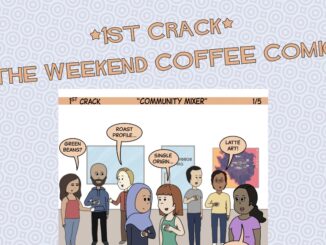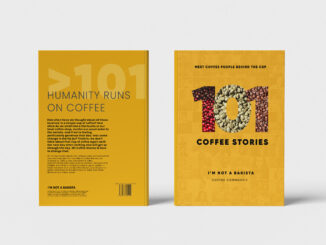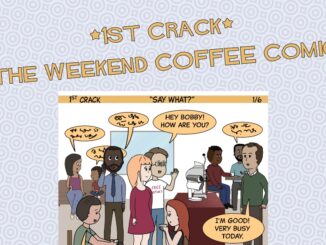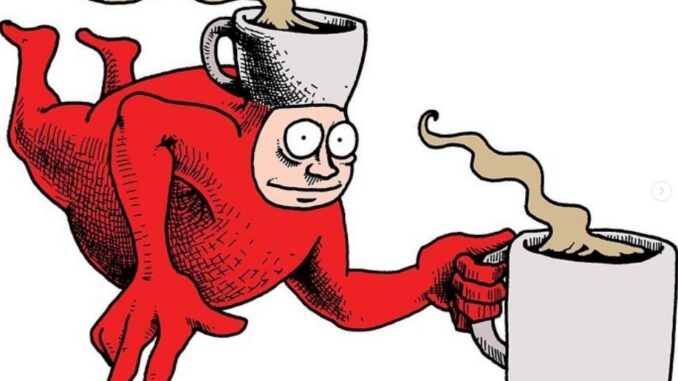
We talk to cartoonist Shannon Wheeler about his classic comic series Too Much Coffee Man.
BY VASILEIA FANARIOTI
SENIOR ONLINE CORRESPONDENT
Photos courtesy of Shannon Wheeler
In this interview, we get to know a bit more about the artist and creator of Too Much Coffee Man, Shannon Wheeler. TMCM is a comic book series that first appeared in the early ’90s and has since become a cult classic. The main character, Too Much Coffee Man, is a superhero with amazing powers derived from coffee. He rarely sleeps and has an excess of caffeine, giving him the ability to go into manic paranoid frenzies in combat.
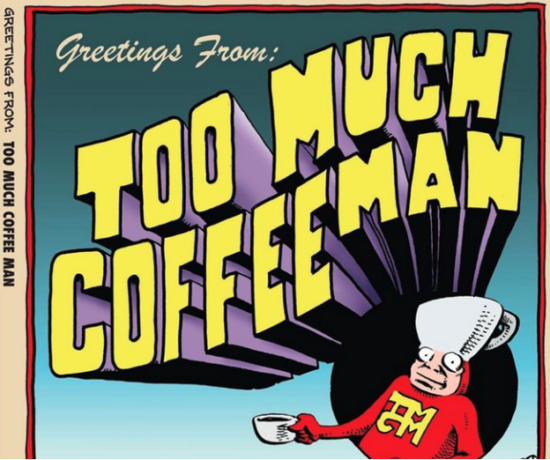
Visually, TMCM parodies superheroes by the hero wearing long underwear with a large mug on his head. The character has been portrayed in outer space and in prison, providing unique comedic insight into strange situations. His secret laboratory, where he creates his extra potent espresso mix, can be found above the local coffee shop, where he spends much of his time debating with cohorts.
This year, Shannon launched a now fully funded Kickstarter campaign to publish the TMCM comic book series as a single graphic novel. We asked him to share his thoughts on why his character is still relevant today and why he chose coffee as a theme.
Barista Magazine: What inspired you to create Too Much Coffee Man, and what influenced the comic’s unique aesthetic?
Shannon Wheeler: I started cartooning when I was a kid. I loved that drawings turned into stories. I started Too Much Coffee Man as a gimmick. I didn’t think it would last past a single gag cartoon, but I hit a vein – it became a voice for something inside. Since then, I haven’t been able to get him to shut up. I’ve been heavily influenced by underground comics like the Fabulous Furry Freak Brothers and Robert Crumb.
Basil Wolverton (MAD magazine) is absolutely one of my favorites. When I got to do some cartoons for MAD, it was a dream come true. I minimized my style when I started doing cartoons for The New Yorker. I dropped all the cross-hatching and made the postures of the characters simpler. When I draw Too Much Coffee Man, now I try to push the weirdness.

The comic often satirizes politics and urban life—why did you choose coffee culture as the lens through which to explore these issues?
Coffee culture has long been the haven for ideas … people sit around and talk. The Boston coffeehouse and tavern the Green Dragon is often credited as the “headquarters of the revolution.”
Do you feel the role of coffee in society has changed since you wrote the original stories? If so, how?
I still go to coffee shops and end up in good conversation. It’s changed—but it’s also stayed the same. I used to go and talk to people, there was a guy playing guitar, cartoonists would show up and we’d draw together. I can get the same vibe, but I have to invite friends out. It’s the same in that there’s still conversation. It’s changed in that now I have to be deliberate and invite people.
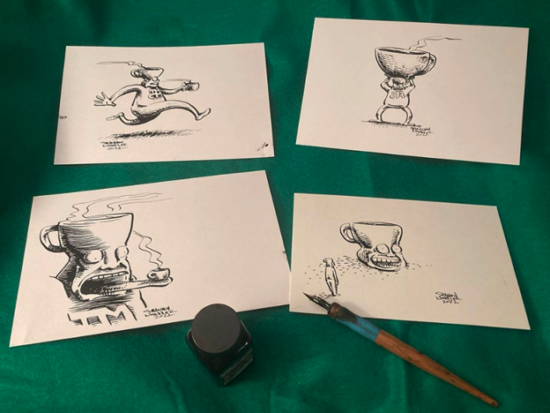
Your Kickstarter project has been fully funded—congratulations! How do you think the graphic novel will be received by today’s readers, given that the stories are set in the 1990s?
There are some jokes that won’t make sense. I mocked The Death of Superman in comics. In response, I killed TMCM (in the fifth issue) on every odd page and brought him back on every even page. The jokes still hold up, but they were funnier when Superman was everywhere. Mostly I try to work with universal themes; love, death, stupidity. I like to ask questions … in The Love Issue, Too Much Coffee Man falls in love with his barista but is afraid to talk to her. Why does love inspire fear? Is it insecurity? Why do we fall in love with people we don’t know? I like to say, unrequited love is like hitting your head against a wall that isn’t there.
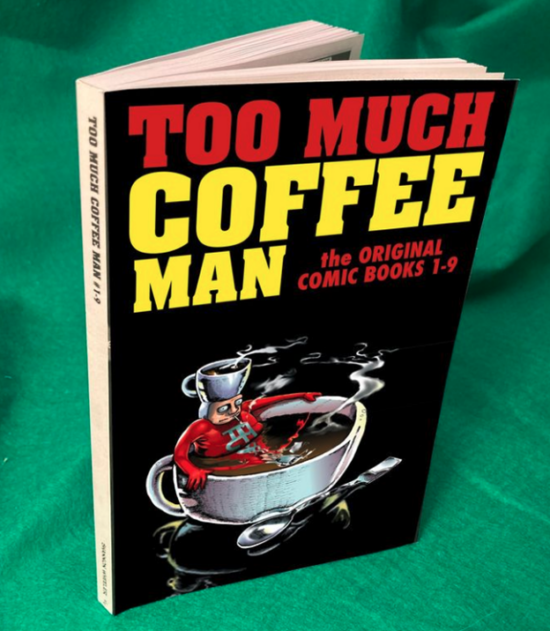
What would you say is the most important message of Too Much Coffee Man, and do you feel this message is still relevant today?
Be curious. Our culture is full of fear. We’re afraid to offend. Every opinion comes with caveats. I’m as guilty as everyone else. Every time I have a good idea, my first thought is, I can’t do that. I skipped two issues of my comic book. I went from #5 to #8. It’s against the rules, I thought. What rules? Who made the rules? Why do I think they’re there? It was funny. Why was I so afraid of doing it? One comic I published with friends, we shot with a gun. When the idea was first suggested, the resistance was intense. We can’t do that. It’s too expensive. We’ll get sued. We ended up overcoming our own fear and shooting the comic. I’m glad we did it.
Do you have any plans to create more Too Much Coffee Man stories in the future, or are you working on any other projects that you can tell us about?
I wouldn’t mind re-staging the Too Much Coffee Man Opera. That was a weird production. A friend of mine writes operas and solicited me to write a libretto. I pulled in a poet friend to help, and two years later we had an opera. I wrote it so it could be performed in coffee shops, but we ended up having a run at the Portland Center for Performing Arts to sold-out audiences and great reviews.
Since then, it’s been put on in Berkeley, Albuquerque, Seaside, San Diego, and a few other places. It hasn’t been in Portland for a number of years—it would be nice to see it again. I’m working on a comic book version of it. It’ll be funny to have a comic based on an opera based on a comic.

Last question! Can you share with Barista Magazine’s readers what is inside Too Much Coffee Man’s potent brew of espresso?
Whatever is at hand! I’m a coffee snob, but I don’t begrudge any personal preference.
Shipping of the graphic novel will start in the coming weeks, so head over to Kickstarter if you’d like to snag your own copy!
ABOUT THE AUTHOR
Vasileia Fanarioti (she/her) is a senior online correspondent for Barista Magazine, and a freelance copywriter and editor with a primary focus on the coffee niche. She has also been a volunteer copywriter for the I’M NOT A BARISTA NPO, providing content to help educate people about baristas and their work. You can follow her adventures at thewanderingbean.net.



